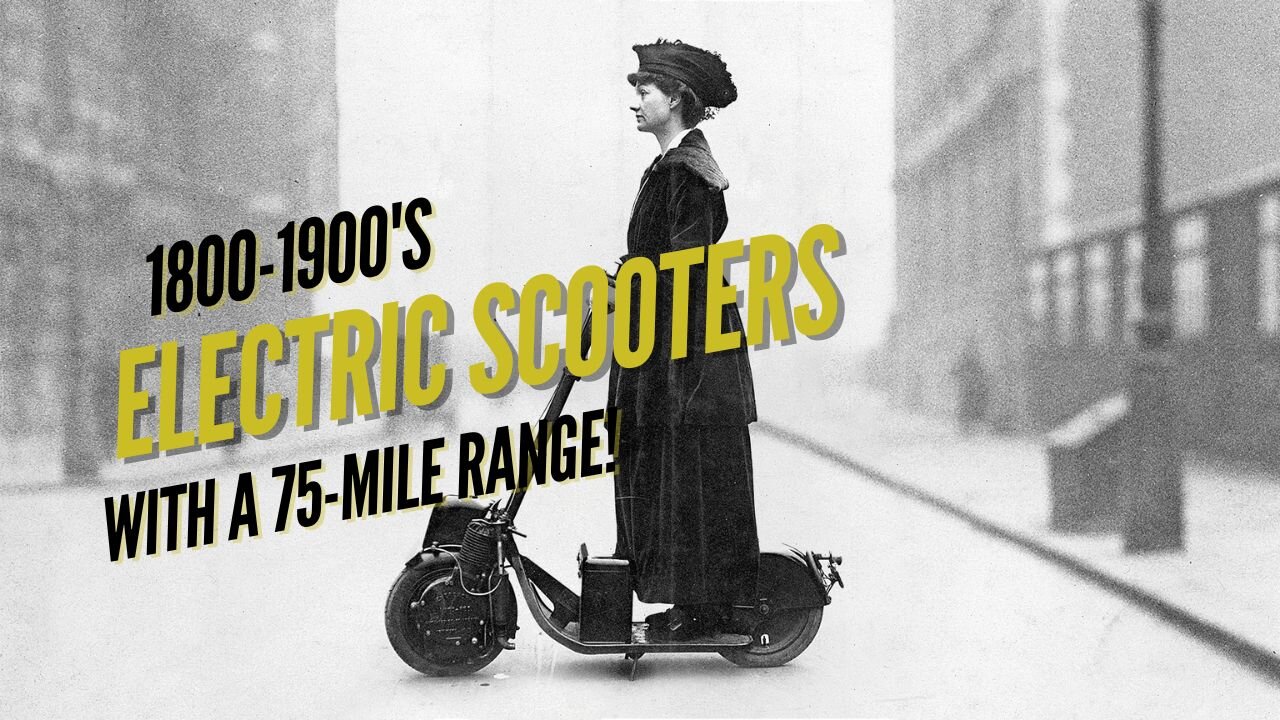Premium Only Content

Look at these Electric Scooters from the 1800-1900's with a 75-Mile Range!
The Autoped - Pioneering Motorized Scooters
In the early 20th century, as cities buzzed with excitement over new inventions, the Autoped made its debut in the heart of New York in 1915. This groundbreaking vehicle marked the world's first glimpse into the potential of motorized scooters. Unlike its human-powered predecessors, the Autoped featured a compact engine, allowing riders to experience the thrill of speed without manual exertion. Its design was both practical and avant-garde, with 10-inch wheels, a robust frame, and a collapsible steering column. The Autoped's inventor, Arthur Hugo Cecil Gibson, had a keen eye for detail and a passion for mobility, driving its conception and design.
The Autoped was an early motor scooter or motorized scooter manufactured by the Autoped Company of Long Island City, New York from 1915 to 1922.
The driver stood on a platform with 10-inch tires and operated the machine using only the handlebars and steering column, pushing them forward to engage the clutch, using a lever on the handlebar to control the throttle, and pulling the handlebars and column back to disengage the clutch and apply the brake. After riding, the steering column would be folded onto the platform to store the scooter more easily. The engine was an air-cooled, 4-stroke, 155 cc engine over the front wheel. The bike came with a headlamp and tail lamp, a Klaxon horn, and a toolbox. It was quite efficient, but was not widely distributed.
A patent for the Autoped as a "self-propelled vehicle" was applied for in July 1913 and granted in July 1916. An early description of the Autoped described it as having a hollow steering column that acted as the fuel tank. However, the production version had a fuel tank above the front mudguard.
The Autoped went out of production in the United States in 1921, but was manufactured by Krupp in Germany from 1919 to 1922.
Elmer R. Johnson and the Electric Scooter
Most sources credit Elmer R. Johnson, a physicist and inventor, with creating the first electric scooter in 1915. Johnson's design was a significant innovation, liberating people from reliance on gas-powered vehicles for transportation. His electric scooter offered a cleaner and quieter alternative, paving the way for future developments in personal mobility. Johnson's vision contributed to the evolution of electric scooters, setting the stage for their eventual resurgence in the modern era.
The concept of the scooter stretches back at least a century before to 1817 and Baron Karl von Drais de Sauerbrun of Germany. After he debuted his early two-wheeled, human-powered ride, the velocipede concept was quickly spun off into bicycles, tricycles and kick scooters. Give or take a few decades, the transportation was being motorized, too, with rear treadle drives popping up in Scotland around the 1840s, according to the Encyclopedia Britannica. Come the turn of the 19th century, battery-powered machines were also entering into the fold; Ogden Bolton Jr. was issued a U.S. patent for his battery-powered bicycle in 1895.
December 31, 1895 - Ogden Bolton Jr. was granted the First Patent for a Battery-Powered Bicycle
The bicycle included 6-pole brush-and-commutator direct current (DC) hub motor mounted in the rear wheel.
Patent Information
Publication number: US552271 A
Patent Title: Electrical bicycle
Publication type: Grant
Publication date: Dec 31, 1895
Filing date: Sep 19, 1895
Publication number: US 552271 A, US 552271A, US-A-552271, US552271 A, US552271A
Inventors: Ogden Bolton
SOURCE
NeEd InPuT
-
 16:25
16:25
The Aquarius Bus
4 months agoSalt Lake City, Utah. 1860. Built or Found? Again, where are the people?
1.41K6 -
 LIVE
LIVE
Steven Crowder
1 hour ago🔴 What We've Missed | A Pop Culture Catch-Up
27,399 watching -
 LIVE
LIVE
Tim Pool
42 minutes agoAmerica's Obesity & Health Crisis, MAKE AMERICA HEALTHY AGAIN | The Culture War with Tim Pool
3,208 watching -
 LIVE
LIVE
Randi Hipper
44 minutes agoDonald Trump makes HISTORY with Strategic Bitcoin Reserve Announcement
658 watching -
 49:45
49:45
BonginoReport
4 hours agoTrump’s Cryptic Putin Threat (NEW STUDIO) (Ep.155) - 03/07/2025
27K53 -
![🔴[LIVE] Breaking Market News, Powell Conference & Trump Speech || The MK Show](https://1a-1791.com/video/fwe2/c1/s8/1/4/f/p/q/4fpqy.0kob-small-The-MK-Show-Mar.-7th.jpg) LIVE
LIVE
Matt Kohrs
10 hours ago🔴[LIVE] Breaking Market News, Powell Conference & Trump Speech || The MK Show
1,520 watching -
 LIVE
LIVE
Wendy Bell Radio
5 hours agoWho's Your Daddy?
13,898 watching -
 LIVE
LIVE
Jeff Ahern
1 hour agoFriday Freakout with Jeff Ahern (Dems Keep Losing)
426 watching -
 1:11:37
1:11:37
LFA TV
13 hours agoThe MOST PRECIOUS Commodity of ALL!! | WORLD HD 3.7.25 8AM
17.6K1 -
 10:25
10:25
Melonie Mac
22 hours agoThe Last of Us 3 won't be happening by the look of it
37.4K53